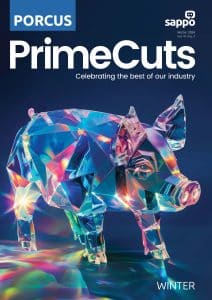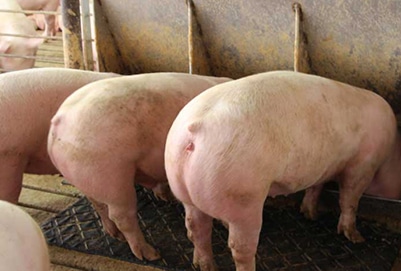Feed accounts for around 70% of costs on pig farms but producers could trim this if they tackled wastage from inefficiencies and poor feed management.
An AHDB Pork study estimates that 5-20% of pig feed can be wasted on farm.
Pig nutritionist Dr Phil Baynes says waste from faulty feed bins and troughs and vermin contamination are major contributors to costs on pig units but these are avoidable.
Poor feed conversion ratios also represent a waste of feed, through inefficiency.
Dr Baynes calculates that at current prices, an increase of just 0.1 in Feed Conversion Rate (FCR) leads to a 10% rise in feed cost. “Improving FCR by reducing waste is critical in the rearing herd,’’ he said.
Here are his top tips for reducing waste.
Fix leaky hoppers
Problem: Wastage is higher when feeders are in a poor state of repair.
Action required:
- Examine feeders between batches – if there is a hole, fix it, or replace the feeder.
- Examine downpipes and feed systems because holes can be hidden.
- Consider replacing older or inefficient feeders with well-designed, efficient feeders that optimise feed inputs while maximising performance.
Put lids on feeders
Problem:
- Without lids, feeders are a feasting ground for vermin. Not only will birds and rodents consume expensive feed but they will also contaminate it so there is a doubling of wastage.
- On average, bird feed intake can be 24g/bird/day.
Action required:
- All feeders should be covered
- If the stockperson needs to examine the feed level, ensure the feeder has a see-through area where this can be assessed.
Don’t allow feeders to over-run
Problem:
- When this happens, feed can be reduced to powder and pigs won’t eat it
- It will also increase dust contamination and respiratory problems
- Feed efficiency can be maximised when pigs have to work for their feed.
Action required:
Explore moreKnow How
- Place less feed in the feeder by lowering the downpipe into the feeder to reduce wastage, although the feed auger may need to run more often.
- Every stockperson on the unit should understand how to adjust feed availability.
- A standard rule is about 50% of self-feeder trough bottom should be visible.
- • Trough bottoms that are completely covered with feed are probably wasteful.
Feed the right rations
Problem:
- Maintaining expensive early diets for longer than needed increases costs.
- If you use the wrong feed it is bad for performance or you over-supply nutrients that pigs can’t physically use and therefore waste.
Action required:
- Pigs should move progressively to lower density, and therefore less expensive diets in accordance with their stage of maturity and legal requirement.
- Regular feed budget audits will ensure feed intakes are appropriate for the stage of production.
- Formulate diets based on input requirements. Lysine, for example, must be appropriate to the stage of production and other amino acids provided in the correct balance. If these are not given in the right ratio it will impact on muscle development, as well as other metabolic functions. These ingredients are expensive so if you are feeding too much it is wasteful because it will just be deaminated and expelled in the urine.
Prepare feed correctly
Problem:
- If grains are not prepared correctly it can result in waste because they will be undigested and passed out whole.
Action required:
- Feed must be correctly ground or rolled, although the final grist size will depend on the feeding system. For instance, a smaller grist is favourable in wet feed systems.
Position feeders and drinkers in the right place
Problem:
- Pigs like to drink shortly after feeding – if drinkers are more than two metres from the feeder they will walk between the feeder and drinker.
- Food carried in their mouths will then drop on the floor and bedding.
Action required:
- Ensure pigs don’t have to cross the sleeping area to get from the feeder to the drinker.
Avoid mycotoxin contamination
Problem:
- Mycotoxins can cause significant health and performance problems.
- Fungal infestation is influenced mainly by moisture level, temperature and availability of oxygen.
Action required:
- Ensure feed is stored correctly and monitor for contamination.
- Avoid grain that is damaged, immature, drought-stricken or otherwise stressed, as it will be more susceptible to mould growth.
Avoid overcrowding in pens
Problem:
- Overcrowding is likely to reduce daily feed intake, especially if there is competition for feeders, decreasing growth rates and impacting on the FCR.
- There is a direct linear relationship between stocking density and growth rates, as reported in many scientific studies. Having only one or two pigs more per pen can result in more than 50g/day reduction in growth rates. This can be addressed partially by an increase in nutrient density of the feed and supply of another water access point.
- The wastage therefore comes from either under- or over-providing energy. Too little and the growth rate slows down, days to slaughter increase and there is a cost to subsequent additional maintenance days.
- Too much energy relative to digestible amino acids can lead to pigs not meeting the grading requirements. Money is then lost from excess expensive energy being spent on the diet, coupled with a loss of revenue from a less-than ideal carcase.
Action required:
- Calculate the ideal stocking density per department to avoid a bottleneck.
- Either consider revising the size of the breeding herd or look to sell some younger pigs to meet the stocking density in the rearing accommodation.
Check water flow rates
Problem:
- Depending on the weight of the pig, the water flow rate should be 0.5 to 2 litres/minute to encourage higher feed intakes.
- Often flow rates can be less than this because of water quality issues or obstruction from mineral and grit build-up.
- The relationship is around 2.5 to 2.75 water to feed intake. By restricting water access, feed intakes subsequently suffer and this increases time to slaughter and reducing feed efficiency.
Action required:
- Check that flow rates are consistent with requirements.
- If they are not, consider changing the delivery system or cleaning the lines with either a dairy cleaner or appropriate organic acid blend.
Ensure good hygiene
Problem:
- Dirty pens increase the antigen challenge for pigs.
- As with stocking density, this can easily lead to a reduction in growth rates by 50g/day or more as the immune system uses protein and energy to mount a response, rather than using these nutrients for growth.
Action required:
- Clean, disinfect and dry pens between batches.
- If using straw, use the cleanest straw possible to avoid potential problems with mycotoxins. If this is not possible, add a good quality mycotoxin binder in the feed.
UK Farmers Weekly, September 2018
The South African Pork Producers’ Organisation (SAPPO) coordinates industry interventions and collaboratively manages risks in the value chain to enable the sustainability and profitability of pork producers in South Africa.









